Global Brucellosis Vaccines Market By Type, By Species, By Application, By End-User, By Region & Segmental Insights Trends and Forecast, 2024 – 2034
- Industry: Healthcare
- Report ID: TNR-110-1273
- Number of Pages: 420
- Table/Charts : Yes
- August, 2024
- Base Year : 2024
- No. of Companies : 10+
- No. of Countries : 29
- Views : 10044
- Covid Impact Covered: Yes
- War Impact Covered: Yes
- Formats : PDF, Excel, PPT
Brucellosis is a zoonotic infection caused by bacteria belonging to the genus Brucella. It primarily affects livestock, but it can also infect humans through direct contact with infected animals or their products. Vaccines have been a crucial tool in combating brucellosis, especially in livestock populations. These vaccines help prevent the spread of the disease and protect both animals and humans.
The first brucellosis vaccines were developed in the early 20th century using killed Brucella bacteria. While these vaccines offered some protection, they often required multiple doses and had limited efficacy.
Global Impact:
The development of brucellosis vaccines has had a significant impact on public health. By reducing the prevalence of the disease in livestock, these vaccines have helped to protect human health and improve food safety. However, challenges remain, such as the need for safer and more effective vaccines, particularly for human use. The global brucellosis vaccines market was worth US$ 263.9 Mn in 2023, anticipated to gain CAGR of 5.45% during 2024 – 2034.
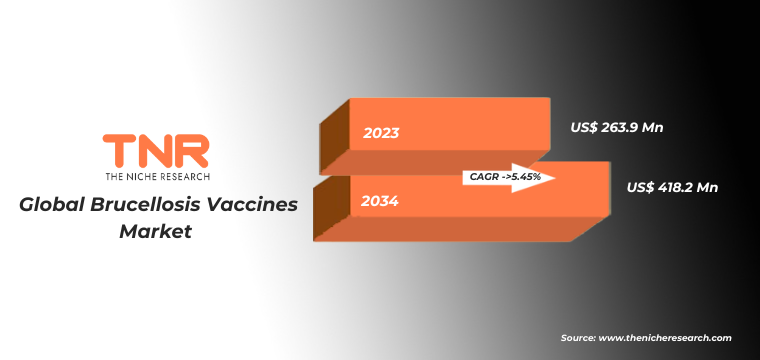
Global Prevalence: Brucellosis continues to be a significant public health concern, particularly in regions with large livestock populations and less developed veterinary healthcare systems. Globally, the disease is responsible for an estimated 500,000 new human cases annually. These figures highlight the persistent threat that brucellosis poses not only to livestock but also to human health. The disease is most prevalent in regions such as the Middle East, Africa, Asia, and Latin America, where livestock farming is a primary source of livelihood. In these regions, the transmission of brucellosis from animals to humans—primarily through direct contact with infected animals or consumption of contaminated animal products—remains a critical challenge. The high incidence of the disease in these areas underscores the urgent need for widespread and effective vaccination programs to control and eventually eradicate brucellosis.
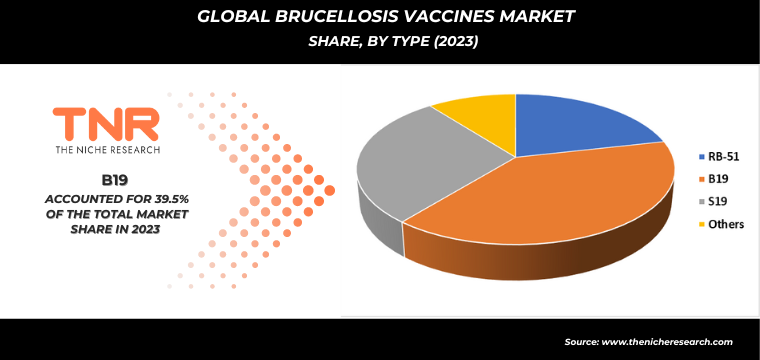
Vaccine Effectiveness: Vaccination has proven to be a critical tool in controlling brucellosis in livestock. Vaccines like the S19 and Rev. 1, which are widely used in cattle and small ruminants respectively, have shown high effectiveness in reducing the incidence of the disease among animals. For instance, in regions where vaccination programs have been implemented successfully, there has been a significant decline in the number of new brucellosis cases in livestock. However, the situation is more complex when it comes to human brucellosis. Although human brucellosis is primarily managed through antibiotics, there is ongoing research into the development of vaccines for humans. The effectiveness of these potential vaccines varies, and they are not yet widely available. The variability in effectiveness is partly due to the complex nature of the human immune response to Brucella bacteria, and the need for vaccines that can provide long-lasting protection without causing adverse effects. Therefore, while animal vaccines have made substantial progress in controlling the disease, more research is needed to achieve similar success in human vaccination.
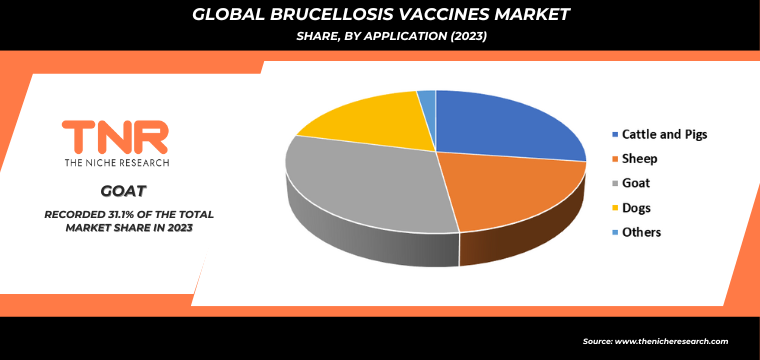
Research Efforts: Significant research efforts are underway to develop new vaccine technologies and improve the safety and efficacy of existing brucellosis vaccines. One of the key areas of focus is the development of recombinant vaccines, which are designed to be safer and more targeted than traditional live attenuated vaccines. These vaccines work by introducing specific antigens—proteins that stimulate the immune system—without using live bacteria, thereby reducing the risk of adverse reactions Another key focus of current research is the creation of more effective vaccine delivery systems. For example, researchers are working on developing vaccines that can be administered orally or through nasal sprays, which would simplify distribution and administration during large-scale vaccination campaigns, especially in areas with limited veterinary services.
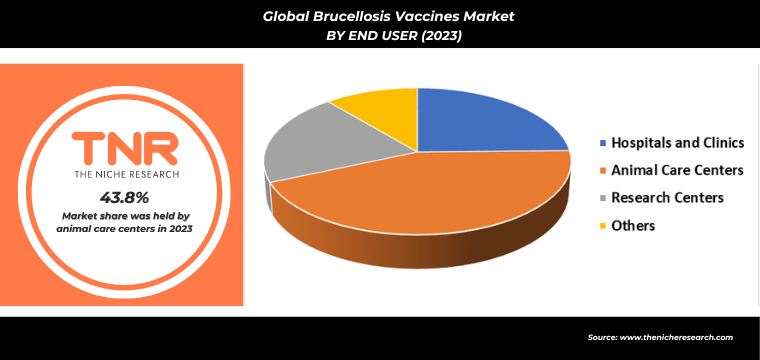
The Brucella abortus segment is poised to hold a considerable share in the global brucellosis vaccines market. Brucella abortus is the primary causative agent of brucellosis in cattle, a species of significant economic importance worldwide. The disease leads to substantial losses in milk production, causes abortions, and reduces meat yield, making effective vaccination a critical need in cattle farming. Consequently, there is a strong demand for vaccines specifically targeting Brucella abortus. Additionally, many countries with large cattle industries, such as the United States, Brazil, Argentina, and India, have established national vaccination programs to combat Brucella abortus. These programs often involve vaccines like S19 and RB51, which are widely used to protect against the disease. The broad implementation of such vaccination campaigns drives the substantial market share for the Brucella abortus segment.
Furthermore, the economic impact of Brucella abortus on cattle farming has led to robust regulatory support for vaccination efforts. In many regions, vaccination against Brucella abortus is either mandatory or strongly recommended by governmental agencies, further boosting demand. The global distribution of cattle farming ensures a consistent need for these vaccines, particularly in regions where livestock farming is a major economic activity. This widespread demand contributes to the significant market share held by the Brucella abortus segment. Additionally, ongoing research and development efforts focused on improving vaccine efficacy, safety, and delivery methods continue to enhance the appeal of Brucella abortus vaccines, solidifying this segment’s dominance in the global brucellosis vaccines market.
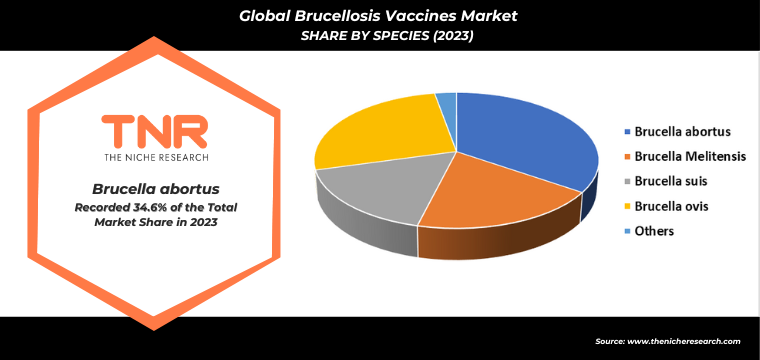
Asia Pacific region to dominate the global brucellosis vaccines market in 2023. This growth is primarily driven by the large livestock populations in countries like China, India, and Vietnam, making them particularly vulnerable to brucellosis outbreaks. Additionally, increasing awareness about the disease and its economic impact, coupled with government initiatives to promote animal health and food safety, are expected to fuel demand for brucellosis vaccines market in this region. Furthermore, the presence of major pharmaceutical companies and research institutions in the Asia Pacific is likely to contribute to the development and production of innovative vaccines, further solidifying its position in the global brucellosis vaccines market.
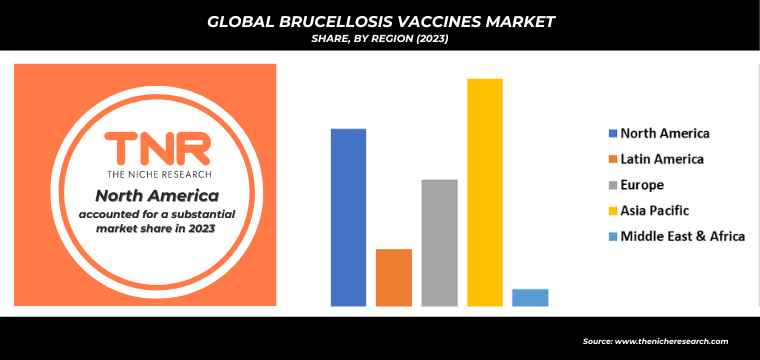
Key companies operating in the global brucellosis vaccines market are:
- Ceva
- Colorado Serum Company
- Creative Biolabs
- CZ Veterinaria S.A.
- Fivet Animal Health
- Hester Biosciences Limited
- Indian Immunologicals Ltd.
- Jordan Bio-industries Center
- LABORATORIOS SYVA
- MSD Animal Health
- Sanvita Biotech
- Tecnovax
- veterinary technologies corporation
- Zoetis
- Other Industry Participants
Brucellosis Vaccines Market Scope:
| Report Specifications | Details |
| Market Revenue in 2023 | US$ 263.9 Mn |
| Market Size Forecast by 2034 | US$ 418.2 Mn |
| Growth Rate (CAGR) | 5.45% |
| Historic Data | 2016 – 2022 |
| Base Year for Estimation | 2023 |
| Forecast Period | 2024 – 2034 |
| Report Inclusions | Market Size & Estimates, Market Dynamics, Competitive Scenario, Trends, Growth Factors, Market Determinants, Key Investment Segmentation, Product/Service/Solutions Benchmarking |
| Segments Covered | By Type, By Species, By Application, By End-User |
| Regions Covered | North America, Europe, Asia Pacific, Middle East & Africa, Latin America |
| Countries Covered | U.S., Canada, Mexico, Rest of North America, France, The UK, Spain, Germany, Italy, Nordic Countries (Denmark, Finland, Iceland, Sweden, Norway), Benelux Union (Belgium, The Netherlands, Luxembourg), Rest of Europe, China, Japan, India, New Zealand, Australia, South Korea, Southeast Asia (Indonesia, Thailand, Malaysia, Singapore, Rest of Southeast Asia), Rest of Asia Pacific, Saudi Arabia, UAE, Egypt, Kuwait, South Africa, Rest of Middle East & Africa, Brazil, Argentina, Rest of Latin America |
| Key Players | Ceva, Colorado Serum Company, Creative Biolabs, CZ Veterinaria S.A., Fivet Animal Health, Hester Biosciences Limited, Indian Immunologicals Ltd., Jordan Bio-industries Center, LABORATORIOS SYVA, MSD Animal Health, Sanvita Biotech, Tecnovax, veterinary technologies corporation, Zoetis, Other Market Participants |
| Customization Scope | Customization allows for the inclusion/modification of content pertaining to geographical regions, countries, and specific market segments. |
| Pricing & Procurement Options | Explore purchase options tailored to your specific research requirements |
| Contact Details | Consult With Our Expert
Japan (Toll-Free): +81 663-386-8111 South Korea (Toll-Free): +82-808- 703-126 Saudi Arabia (Toll-Free): +966 800-850-1643 United Kingdom: +44 753-710-5080 United States: +1 302-232-5106 E-mail: askanexpert@thenicheresearch.com
|
Global Brucellosis Vaccines Market
By Type
- RB-51
- B19
- S19
- Others
By Species
- Brucella abortus
- Brucella Melitensis
- Brucella suis
- Brucella ovis
- Others
By Application
- Cattle and Pigs
- Sheep
- Goat
- Dogs
- Others
By End User
- Hospitals and clinics
- Animal Care Centers
- Research Centers
- Others
By Region
- North America (U.S., Canada, Mexico, Rest of North America)
- Europe (France, The UK, Spain, Germany, Italy, Nordic Countries (Denmark, Finland, Iceland, Sweden, Norway), Benelux Union (Belgium, The Netherlands, Luxembourg), Rest of Europe)
- Asia Pacific (China, Japan, India, New Zealand, Australia, South Korea, Southeast Asia (Indonesia, Thailand, Malaysia, Singapore, Rest of Southeast Asia), Rest of Asia Pacific)
- Middle East & Africa (Saudi Arabia, UAE, Egypt, Kuwait, South Africa, Rest of Middle East & Africa)
- Latin America (Brazil, Argentina, Rest of Latin America)
Report Layout:
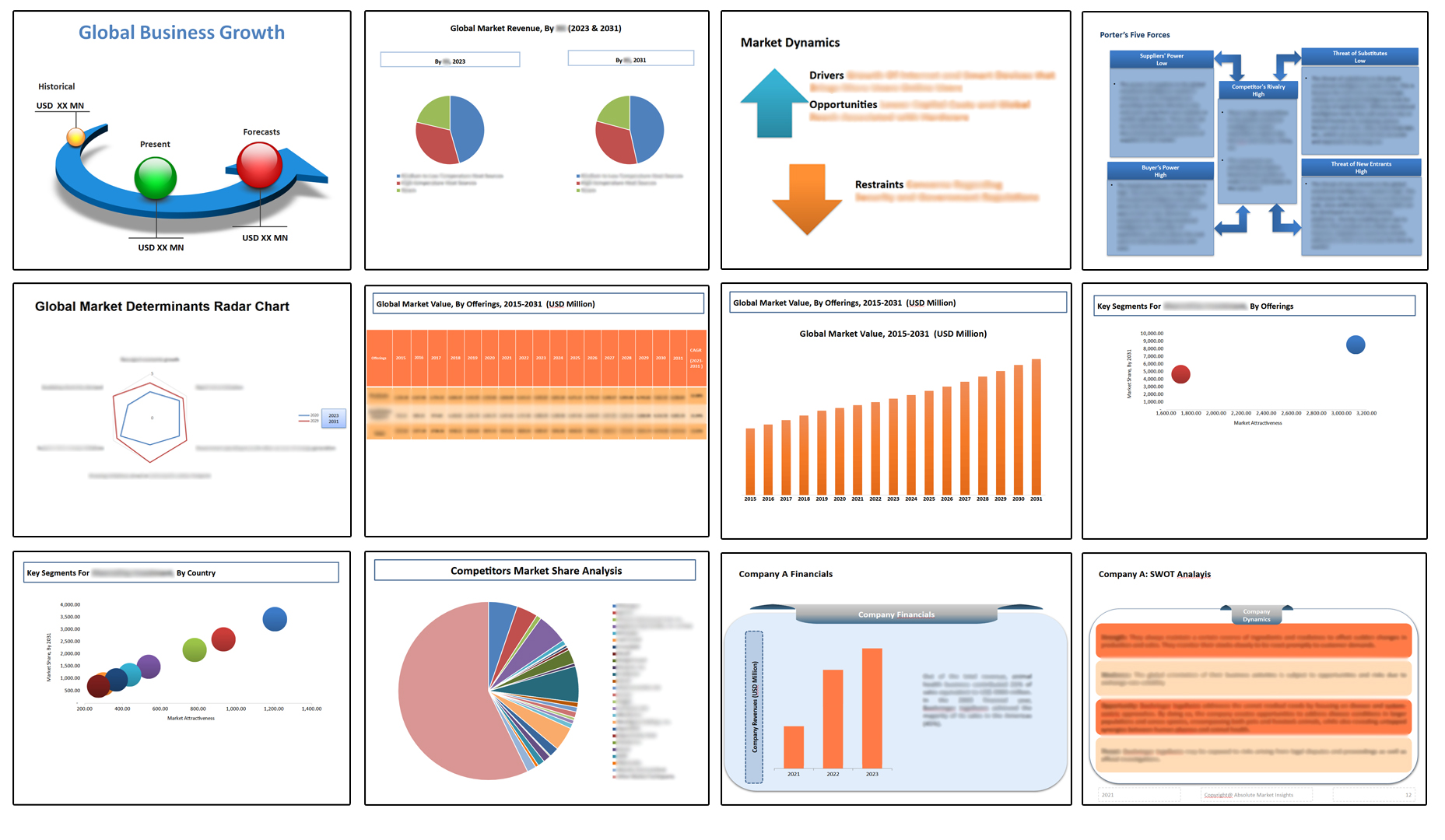
Table of Contents
Note: This ToC is tentative and can be changed according to the research study conducted during the course of report completion.
**Exclusive for Multi-User and Enterprise User.
Global Brucellosis Vaccines Market
By Type
- RB-51
- B19
- S19
- Others
By Species
- Brucella abortus
- Brucella Melitensis
- Brucella suis
- Brucella ovis
- Others
By Application
- Cattle and Pigs
- Sheep
- Goat
- Dogs
- Others
By End User
- Hospitals and clinics
- Animal Care Centers
- Research Centers
- Others
By Region
- North America (U.S., Canada, Mexico, Rest of North America)
- Europe (France, The UK, Spain, Germany, Italy, Nordic Countries (Denmark, Finland, Iceland, Sweden, Norway), Benelux Union (Belgium, The Netherlands, Luxembourg), Rest of Europe)
- Asia Pacific (China, Japan, India, New Zealand, Australia, South Korea, Southeast Asia (Indonesia, Thailand, Malaysia, Singapore, Rest of Southeast Asia), Rest of Asia Pacific)
- Middle East & Africa (Saudi Arabia, UAE, Egypt, Kuwait, South Africa, Rest of Middle East & Africa)
- Latin America (Brazil, Argentina, Rest of Latin America)
The Niche Research approach encompasses both primary and secondary research methods to provide comprehensive insights. While primary research is the cornerstone of our studies, we also incorporate secondary research sources such as company annual reports, premium industry databases, press releases, industry journals, and white papers.
Within our primary research, we actively engage with various industry stakeholders, conducting paid interviews and surveys. Our meticulous analysis extends to every market participant in major countries, allowing us to thoroughly examine their portfolios, calculate market shares, and segment revenues.
Our data collection primarily focuses on individual countries within our research scope, enabling us to estimate regional market sizes. Typically, we employ a bottom-up approach, meticulously tracking trends in different countries. We analyze growth drivers, constraints, technological innovations, and opportunities for each country, ultimately arriving at regional figures.Our process begins by examining the growth prospects of each country. Building upon these insights, we project growth and trends for the entire region. Finally, we utilize our proprietary model to refine estimations and forecasts.
Our data validation standards are integral to ensuring the reliability and accuracy of our research findings. Here’s a breakdown of our data validation processes and the stakeholders we engage with during our primary research:
- Supply Side Analysis: We initiate a supply side analysis by directly contacting market participants, through telephonic interviews and questionnaires containing both open-ended and close-ended questions. We gather information on their portfolios, segment revenues, developments, and growth strategies.
- Demand Side Analysis: To gain insights into adoption trends and consumer preferences, we reach out to target customers and users (non-vendors). This information forms a vital part of the qualitative analysis section of our reports, covering market dynamics, adoption trends, consumer behavior, spending patterns, and other related aspects.
- Consultant Insights: We tap into the expertise of our partner consultants from around the world to obtain their unique viewpoints and perspectives. Their insights contribute to a well-rounded understanding of the markets under investigation.
- In-House Validation: To ensure data accuracy and reliability, we conduct cross-validation of data points and information through our in-house team of consultants and utilize advanced data modeling tools for thorough verification.
The forecasts we provide are based on a comprehensive assessment of various factors, including:
- Market Trends and Past Performance (Last Five Years): We accurately analyze market trends and performance data from preceding five years to identify historical patterns and understand the market’s evolution.
- Historical Performance and Growth of Market Participants: We assess the historical performance and growth trajectories of key market participants. This analysis provides insights into the competitive landscape and individual company strategies.
- Market Determinants Impact Analysis (Next Eight Years): We conduct a rigorous analysis of the factors that are projected to influence the market over the next eight years. This includes assessing both internal and external determinants that can shape market dynamics.
- Drivers and Challenges for the Forecast Period:Identify the factors expected to drive market growth during the forecast period, as well as the challenges that the industry may face. This analysis aids in deriving an accurate growth rate projection.
- New Acquisitions, Collaborations, or Partnerships: We keep a close watch on any new acquisitions, collaborations, or partnerships within the industry. These developments can have a significant impact on market dynamics and competitiveness.
- Macro and Micro Factors Analysis:A thorough examination of both macro-level factors (e.g., economic trends, regulatory changes) and micro-level factors (e.g., technological advancements, consumer preferences) that may influence the market during the forecast period.
- End-User Sentiment Analysis: To understand the market from the end-user perspective, we conduct sentiment analysis. This involves assessing the sentiment, preferences, and feedback of the end-users, which can provide valuable insights into market trends.
- Perspective of Primary Participants: Insights gathered directly from primary research participants play a crucial role in shaping our forecasts. Their perspectives and experiences provide valuable qualitative data.
- Year-on-Year Growth Trend: We utilize a year-on-year growth trend based on historical market growth and expected future trends. This helps in formulating our growth projections, aligning them with the market’s historical performance.
Research process adopted by TNR involves multiple stages, including data collection, validation, quality checks, and presentation. It’s crucial that the data and information we provide add value to your existing market understanding and expertise. We have also established partnerships with business consulting, research, and survey organizations across regions and globally to collaborate on regional analysis and data validation, ensuring the highest level of accuracy and reliability in our reports.









